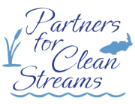 Community Water Action in Toledo (CWAT) has wrapped up its first PCS-coordinated volunteer water quality monitoring season. Learn what volunteers have accomplished so far.
Community Water Action in Toledo (CWAT) has wrapped up its first PCS-coordinated volunteer water quality monitoring season. Learn what volunteers have accomplished so far.
Flowing across an April-October season, the CWAT program allows PCS to coordinator partner organizations’ water monitoring programs by sharing training resources, engaging in volunteer outreach, aligning sampling protocols, and evaluating program success. Kat Kieffer, our Water Monitoring Coordinator Intern, works at the nexus of CWAT’s partnerships. This year, water monitoring volunteers came from Metroparks Toledo, TMACOG’s Student Watershed Watch program, and the Toledo Zoo’s ZOOTeens.
In its inaugural season, CWAT created six shared sampling kits, collectively identified waterway sites to sample, engaged partner organizations’ volunteers and staff in monitoring 18 local sites, sampled each site at least once a month with many sampled twice a month, and shared data in the online Water Reporter database. CWAT engaged more than 60 volunteers in over 100 sampling events, with additional outreach programs demoing CWAT to local youth in Girl Scouts and Connections Camp participants.
Sites were chosen to be representative of different major waterways across our region, and to have diverse characteristics (upstream/downstream, urban/rural, etc.). Another important consideration was ease of access for volunteers, both in terms of sampling on public land but also safety of embankments. Some sites were chosen because they had a years-long history of sampling by partner organizations.
A ZOOTeen mentor shared her success story from frequent participants. She explained that over the course of the summer, visiting sites once or twice a month, the youth volunteers who have done regular monitoring have become familiar with the sites. “They will say, ‘Oh, this is definitely higher than base flow’ or ‘The water looks foamier than usual’ or notice new driftwood or log snags.” These volunteers are engaged and observant, and even across one season, having regular eyes on the waterways has helped them develop a sense of place and ownership.
How do we expect CWAT to grow next year? The biggest way is that we will begin to open up this program to more public volunteers. We also anticipate developing more accessible ways to see the data that’s been collected, so that anyone can learn about the health of our waterways. We expect to increase the rate of sampling, since CWAT already surpassed our initial goal of sampling all sites once a month, with the majority of sites sampled twice a month. And finally, we hope to include new partners to expand this program’s geographic reach, particularly along the Portage River.
Keep an eye on our website, social media, and newsletter for updates in the spring on this opportunity.
